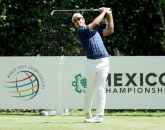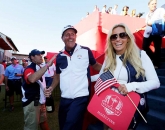4. Statistics and Bad Lies
The word is out, golf is in perfect health, basking in its post-Olympic euphoria, talk of millions of youngsters taking up the game in medalhungry countries such as China and India, even Russia, I read somewhere recently, a sudden and inexplicable reversal in decline in participation levels in traditional golf territories such as North America and Europe, forecasts that the Olympics in Brazil will see South Americans disavow a passion for football that is in their DNA, only to take up the royal and ancient game.
Golf’s powerbrokers, from the R&A, to the USGA, the IGF, almost every acronym associated with golf, have spent the post-Olympic period insisting that not only is all well, in fact, it’s never been better.
Why then has Nike, admittedly a relative latecomer to the game inspired by the rise and rise of Tiger Woods recently announced it is withdrawing, lock, stock and barrel, from golf equipment, clubs, balls, the lot, with TaylorMade making similar sounds.
Speaking at the recent HSBC Golf Business Forum in the USA, Jack Nicklaus, a man who knows a thing or two about the true state of the game, from his course design, Golden Bear brands and country club portfolio said, “Fact is, more golf courses have closed in the US in each of the last 10 years than have opened.”
But the legend of the game hit the nail on the head when he said, “Tournament golf is in a healthy state now - healthier than it’s ever been and still on the rise,” which means that a maximum of 1,000 of the 60m golfers worldwide are in a good place, a very good place, some earning a million bucks a year without ever having to make a victory speech.
That’s why, at a ‘State of the Game’ interview with Forbes Magazine, Pete Bevacqua, CEO of the PGA of America, Mike Davis, CEO of the USGA, Tim Finchem, (the then) PGA TOUR Commissioner, Steve Mona, CEO of World Golf Foundation or Mike Whan, LPGA Commissioner, all talked their book up relentlessly, without even a nod to the plight facing the recreational, non-elite end of the game which, in the final analysis, is their one and only paymaster.
According to the National Golf Foundation, US golf has lost five-million players over the past decade with 20% of the remaining 25 million golfers likely to quit in the next few years, whilst the number of Millennials aged 18 to 34 participating in sports such as running rose by 29% from 2009 to 2013, during which time, the proportion playing golf fell by 13%.
Same story in Europe, golf participation in England down by 2.5% year-on-year since the Millennium, France, Scandinavia and Spain, same declining trend, China, once the source of optimism is said to be flatlining, India, another great hope has yet to take to golf.
The only light at the end of a very long and potentially dark tunnel is women’s golf, which is forecast to increase by 17% by 2020.
In late 2015, the European Tour announced that golf participation in the UK, far from being in decline, is actually flourishing, especially amongst a younger demographic, Keith Pelley, Chief Executive of The European Tour, saying, “Our ‘Golf Actives Survey’ suggests our sport is very healthy, participation in it is changing and the younger generation have more options to experience our wonderful game.
All of which just goes to show that you can commission consultants to tell you when you want to hear, provide the evidence to support it and remain in denial, or you can read and take heed of the official statistics and listen to the likes of Nike to discover the real picture and act before it’s too late.
The game of golf is in great shape for 0.0015% of its players, for the massive majority of us, until the game’s ‘leaders’ get real and act, it’s like bunker sand slipping slowly but inexorably through the game’s fingers.
Pages
Click here to see the published article.











